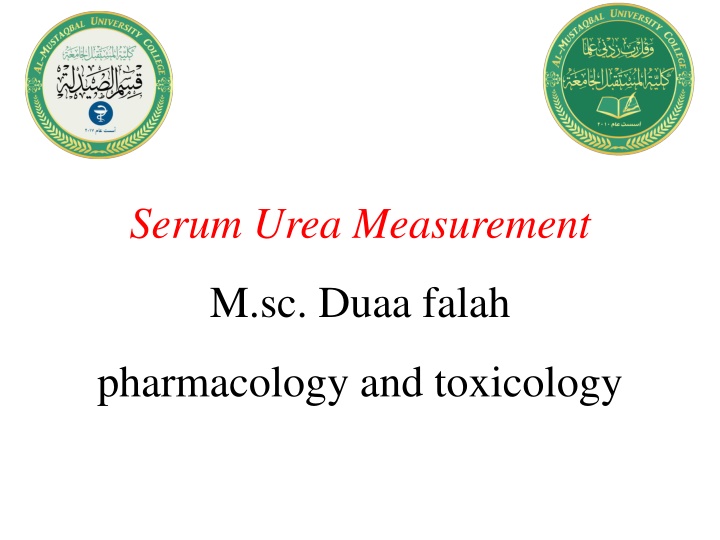
Serum Urea Measurement in Pharmacology and Toxicology
Learn about serum urea measurement, its role as a major excretory product of protein metabolism, urea synthesis in the liver, clinical applications, and factors affecting blood urea nitrogen levels. Discover how increased or decreased blood urea nitrogen may indicate various health conditions.
Download Presentation

Please find below an Image/Link to download the presentation.
The content on the website is provided AS IS for your information and personal use only. It may not be sold, licensed, or shared on other websites without obtaining consent from the author. If you encounter any issues during the download, it is possible that the publisher has removed the file from their server.
You are allowed to download the files provided on this website for personal or commercial use, subject to the condition that they are used lawfully. All files are the property of their respective owners.
The content on the website is provided AS IS for your information and personal use only. It may not be sold, licensed, or shared on other websites without obtaining consent from the author.
E N D
Presentation Transcript
Serum Urea Measurement M.sc. Duaa falah pharmacology and toxicology
Urea Urea is the highest non-protein nitrogen compound in the blood. Urea is the major excretory product of protein metabolism. It is formed in the liver from free ammonia generated during protein catabolism. the most important eliminating excess nitrogen in the human body. Since historic assays for urea were based on measurement of nitrogen, the term blood urea nitrogen (BUN) has been used to refer to urea determination. catabolic pathway for
Urea synthesis Protein metabolism produces amino acids that can be oxidized, this result in the release of ammonia which is converted to urea (via urea cycle) and excreted as a waste product. Following synthesis in the liver, urea is carried out in the blood to the kidney which is readily filtered from the plasma by glomerulus. Most of the urea in the glomerular filtrate excreted in the urine, and some urea is reabsorbed through the renal tubules. The amount reabsorbed depends on urine flow rate and extent of hydration . The concentration of urea in the plasma is determined by renal function, the protein content in diet and the rate of protein catabolism .
Clinical Application Measurement of urea used in : a) Evaluate renal function b) To assess hydration status c) To determine nitrogen balance d) To aid in the diagnosis of renal diseases e) To verify adequacy of dialysis f) Check a person's protein balance
Urea Concentration-plasma Measurement of Blood urea nitrogen (BUN) alone is less useful in diagnosing kidney diseases because it s blood level is influenced by dietary protein and hepatic function . But its diagnostic value improves with serum creatinine values.
Increased blood urea nitrogen (BUN) may be due to: a) Impaired renal function (renal failure) : b) Volume depletion ( increase of urea reabsorption) c) High protein diet d) Catabolic States.
Decreased blood urea nitrogen (BUN) may be due to: a) Liver Disease b) Malabsorption c) Reduced protein intake( Starvation , anorexia)
Estimation of urea in blood serum Principle: Urea is synthesized in the liver from the ammonia produced mostly by the catabolism of amino acids. Kinetic enzymatic estimation of urea uses these reactions: urea + 2 H2O urease 2 NH4+ + CO32- 2-oxoglutarate + NH4+ + NADH glutamate dehydrogenase L- glutamate + NAD+ + H2O Urease hydrolyses urea to ammonia. Glutamate dehydrogenase combines the ammonia with 2-oxoglutarate to form glutamate. In this reaction, the NADH is oxidized to NAD+ and this change is detected photometrically as a decrease in absorbance at 340 nm (Warburg s optical test).
Procedure: 1. Switch the photometer on and let it to heat up for 10 minutes at 37 C. 2. Set up the wavelength to 340 nm and use distilled water to make the blanking. (All the absorbances described further are read against distilled water as a blank.) 3. There are 3 cuvettes available one for the blank reaction, one for the standard reaction and one for the sample (blood serum) reaction:
First the blank reaction will be performed: Pipette 0.02 ml of distilled water into the cuvette and 2 ml of the reagent (working solution) . Second the standard solution 0.02 ml of into the cuvette and 2 ml of the reagent (working solution). Third the serum sample 0.02 ml of into the cuvette and 2 ml of the reagent (working solution). Measure A1 and A2 analogically to the previous measurements .






















